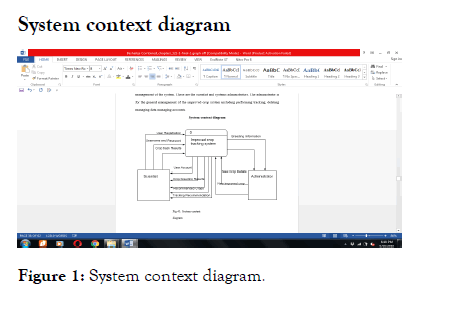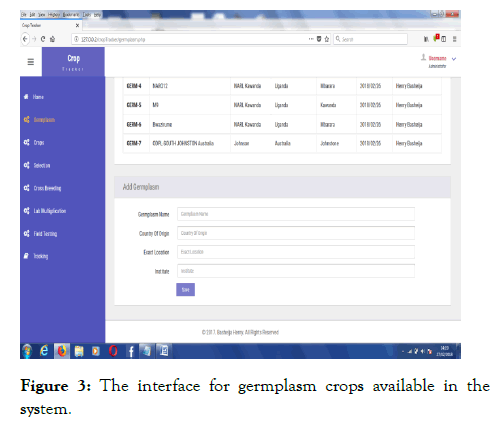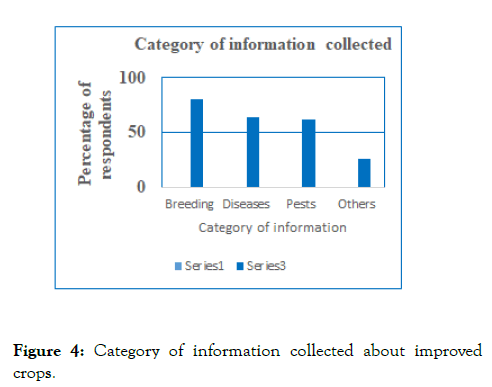Journal of Information Technology & Software Engineering
Open Access
ISSN: 2165- 7866
ISSN: 2165- 7866
Review Article - (2021)
Plant breeding involves application of a collection of techniques aimed at bringing together good parents’ traits to generate a better crop in the progeny. Cross-breeding and selection in plant breeding has been able to considerably improve yields and pest and disease resistance of crops. Efficiency in crop breeding research programs depends upon the ability of breeders and geneticists to effectively and efficiently create, identify, store, track and select recombinant genotypes with a maximum number of desirable traits in the shortest time possible. This was not easily possible with the manual system for storage and management of information lying in large volumes of data generated in all research institutions. Locating files among tons of data is a tedious and time-consuming process for researchers. The need to keep track of research data is significantly becoming important in agricultural research institutions. A study was conceived in response to the need to improve the storage, tracking and dissemination of research data collected during the breeding of improved crops. It was conducted to develop a system for tracking breeding records, at the National Agricultural Research Laboratories (NARL) in Uganda. This was motivated by the increasing need to develop high yielding yet resilient crop varieties due to the constantly changing climate amid other socio-economic changes like population pressure and loss of soil fertility. Different methods were used to design the system which included Dataflow Diagrams (DFDs) and Entity Relationship Diagrams (ERDs). An ERD was used to identify the data to be captured, stored and retrieved in order to support the activities performed in the process of filing and tracking files. As a result, a breeding tracking system was developed in form of an application tool that is able to manage the creation and movement and tracking the originality of files from desk to desk of personnel who work on them. The developed system supports information sharing between scientists as well as easy access to information about good traits in improved crops.
Cross breeding; Soil fertility; Tracking files, Plant breeding
Genetic improvement also known as genetic progress within plants performance is a result of increasing the frequency of desirable genes and decreasing the frequency of the undesirable genes in plants. This preserves the integrity of the parental genotype, inserting only a small additional piece of information that controls a specific trait [1]. A gene is a sequence of nucleic deoxyribonucleic acid (DNA) that contains information that determines a particular characteristic. Genes are located in chromosomes and are units of inheritance that are passed from one generation to the next and provide instructions for development and function of the organism. Crops that are developed through genetic improvement are referred to as genetically improved crops. An improved plant contains a gene or genes, which has been artificially inserted in the process of conventional breeding [2].
Agriculture and biotechnology are critical contributors to solving the global problems of hunger, poverty and environmental degradation. Although major scientific breakthroughs have been realized in engineering, electronics, information technology and medical research, advances [3] in agricultural technologies, the particularly agricultural biotechnology, hold a great potential for economic growth, crop productivity, nutritional quality necessary for reducing poverty and associated challenges in developing countries [4]. In Uganda, the land area under quality agriculture has been steadily declining due to population growth that was 34.9 million in 2014 (National Census-UBOS, 2014At the global level, the world population was 7 billion in 2012 and is expected to reach 9 billion in 2045 (UNDP, 2012). Therefore, a broad range of agricultural genetic diversity needs to be captured, availed and utilized in order to feed this growing population. Climate change is an added threat to biodiversity that will significantly impact genetic resources for food production [5]. Crop production must double by 2050 to meet predicted production demands of the global population . However, achieving this goal will be a significant challenge for plant breeders because crop yields would have to increase at a rate of 2.4% per year, yet the average rate of increase is only 1.3%, with yields stagnating in up to 40% of land under cereal production [6].
Tracking and tracing of improved crops
According to the new regulation in the European Union, traceability is required in all stages of the supply chain, covering all food and feed as well as business operators without prejudice to existing legislation on specific sectors such as grains. A plant research institute must register and keep information such as name, location, status, nature of plant batch number and a more detailed description of the crop. Unless specific provisions for further traceability exist, the requirement for traceability is limited to ensuring that researchers are at least able to identify the immediate origin of the crop as well as immediate subsequent recipient. Managing the huge amount of data and processing useful information from it is a challenge that needs to be answered by developing data management and tracking system for managing improved crops [7]
Germplasm tracking
Information Technologies (IT) benefit crop development by integrating data management and utilization across disciplines and software systems. Efforts to develop new crops must progress from individual, isolated data sets to a realm where information flows smoothly from field and laboratory studies to diverse types of tracking systems capable of linking crop-specific data to information crop improvement. This ranges from ownership of source germplasm to exploitation of indigenous knowledge about potential uses. Careful documentation of the crop development process will provide stakeholders the information needed to manage and track the information about improved crops [8].
The documentation of the entire plant breeding process and tracking information in breeding section, focuses mainly on crossing, selection, multiplication, embryo rescue, micropropagation and field testing. Each genetic entity, whether a single cell, seed packet, tissue culture, is uniquely identified, and the identifier can be associated with alternate names as needed. Sequences of generations are seamlessly linked, allowing historic pedigrees to be traced as far back as records allow. Genetic entities may be characterized using user-specified attributes ranging from origin of germplasm, to plant descriptors [9].
Benefits of information systems for tracking information about improved crops
The role of Management Information System (MIS) in an organization can be compared to the role of a heart in the body. The information is the blood and MIS is the heart. In the body, the heart plays the role of supplying blood to all the elements of the body including the brain. It regulates and controls the incoming impure blood, processes it and sends it to the destination in the quantity needed. It fulfills the needs of blood supply to human body in the normal course and also in crisis [10].
An MIS plays exactly the same role in the organization. The system ensures that appropriate data is collected from the various sources, processed, and sent further to all the necessary destinations. The system is expected to fulfill the information needs of an individual, a group of individuals, the management functions- the managers and the top management. Hence an MIS satisfies the diverse needs through a variety of systems such as query Systems, analysis systems, modeling systems and decision support systems. Therefore, MIS helps in strategic planning, management control, operational control and transaction processing. By comparison with manual systems, Management Information Systems (MIS) have a variety of benefits to an organization namely. Extensive breeding and agronomic efforts over the past 50 years have been responsible for tripling cereal yields. Continuing advances in the techniques available to breeders offer the potential to increase the rate of genetic improvement.
Plant genetic engineers often need to trace traits in improved crops to their original plant. This is done to track the source of a good trait using the breeding collections in order to get the traits for producing other improved crops. This process requires access to data from the field. The starting materials are taken to the laboratory where they are subjected to a number of experiments, before they are released back to the field as improved plants. Currently at Uganda’s National Agricultural Research Organization (NARO), this data is manually collected, entered and stored in personal laboratory books and paper files. As a result, there are a lot of challenges regarding utilization of this data notably: data duplication, difficulty in locating data about specific samples, misinterpretation and wastage of time in locating data. The aim of this project was to develop an information system for tracking information about improved crops. It is hoped that such a system will make it easier to trace some of the good traits found in the improved crops in the process of breeding. Plant breeding can be considered an evolutionary process between humans and edible plants. People caused changes in the plants that were used for agriculture and, in turn, those new plant types allowed changes in human populations to take Place. Plants yielding more generous harvests freed some of the people’s time for developing art, handcrafting, and science, eventually leading to modern human life as we know it. Civilization could not exist without agriculture, and agriculture could not sustain the civilized world without modern crop varieties. From this point of view, it becomes clear that plant breeding is one of the main foundations of civilization.
System design is the process of turning the abstract solution into a practical specification suitable for implementation. The system was designed based on the functional and nonfunctional requirements obtained during requirements collection which described the parameters and the data to be incorporated into the system. Different methods were used to design the system which included Dataflow Diagrams (DFDs) and Entity Relationship Diagrams (ERDs).
To releases the aim of this paper we begin by modeling the proposed tracking system using the Data flow diagram and context diagram. A Data Flow Diagram (DFD) is a graphical representation of the flow of data through an information system, modelling its process aspects. A DFD is often used as a preliminary step to create an overview of the system without going into great detail, which can later be elaborated. Data flow diagrams show the functions performed by a system and the data flowing in the system, what transformations are done on the data, the data flowing out of the system, and the data within the system. They also give graphical representation of the system’s components, processes and the interfaces between them The choice of using the data flow diagram was based on the fact that they are easier to understand by technical and non-technical audiences, they can provide a high level system overview complete with boundaries and connections to other systems, and lastly, they can provide a detailed representation of the system components .It uses diagram to document an objectbased decomposition of systems and to show the interaction between these objects and the dynamics of these objects. The information tracking system was developed as a web application with three tier architecture. Hypertext Pro-Processor (PHP) was used handles data transfer from the user interface to the database and also query request to the database from the user interface Entity Relationship Diagrams (ERDs) were used to model both the logical and physical database structure designs. The entity relationship data model shows the relationships between the entities involved in the system together with their attributes and indicates the number of occurrences an entity can exist for a single occurrence of the related entity. ERDs aid the capture of more details such as data about entities and relationships. An ERD was used to identify the data to be captured, stored and retrieved in order to support the activities performed in the process of filing and paying taxes. ERDs are relatively simple, user friendly and can provide a unified view of data which is independent of any data model.
The reason for choosing PHP is that it is a widely used open source scripting language also PHP is free software and runs on multiple platforms making it platform independent. PHP is compatible with almost all web servers in use today. PHP supports a wide range of databases. It can create open, read, write, delete and close files on the server. It can collect form data and can send and receive cookies. PHP can add delete modify data in a databases and can restrict users from accessing come pages on your website. PHP can encrypt data with PHP diverse output users can be generated. The database management system used is MYSQL. It is the world’s most popular open source database, enabling the cost-effective delivery of reliable, high-performance and scalable web-based and embedded database application. It is ideal for both small and large application .MYSQL is very fast, reliable and easy to use. It supports standard SQL. MYSQL compiles on a numbers of platform. It is free to download and use and is developed, distributed, and supported by Oracles corporation .Cascading Style Sheets (CSS) come in handy for styling the user interfaces there by making them aesthetically pleasing to the would be users of the system.
Context diagram
A context diagram is a data flow diagram that summarizes all processing activities within the system in single process symbol. It describes the highest level view of the system, shows a system as a whole with inputs and outputs from/to external factors. It was used to describe in general context of the system by identifying all the external entities or users interacting with the improved crop system. The information they feed into the system and the feedback from the system. Data flow diagrams are a network representation of a system (Figure 1).

Figure 1: System context diagram.
Administration user interface
Login page: This is an interface that gives the user access to the system .when the application loads it prompt the login interface which requires the user to enter the username and password and then click the login button, the login page for users is shown in Figure 2.
Figure 2: Crop tracker login.
Germplasm: Germplasm is a living genetic resource such as seeds or tissues that are maintained for the purpose of plant breeding, preservation, and other research uses. It can be a seed or another plant part like a leaf, a piece of stem, pollen or even just a few cells that can be turned into a whole plant. germplasm collections can range from collections of wild species to elite, domesticated breeding lines that have undergone extensive human selection. The germplasm component contains information for a plant name, genetic makeup and a valuable natural resource of plant diversity. Genetic diversity of germplasm gives plant breeders the sustained ability to develop new high yielding, high quality varieties that can resist constantly evolving pests, diseases and environmental stresses. In the system, this component allows scientists to capture and store information about germplasm. While entering germplasm records it has germplasm name it’s a name given to the germplasm generated by the breeder, Institute it is the institute where germplasm was generated from, Exact location this is the location where the germplasm is located (Figure 3).

Figure 3: The interface for germplasm crops available in the system.
Category of information collected, stored and used about improved crops: As shown in Table 1 and Figure 4, different crop researchers collect different information depending on the research they are conducting. Most researchers collect information about breeding at 80%, 64%, collect information about diseases while 62 % collect information about pests.

Figure 4: Category of information collected about improved crops.
| Information Category | Total number of Respondents | Frequency | Percent |
|---|---|---|---|
| Breeding | 50 | 40 | 80 |
| Diseases | 50 | 32 | 64 |
| Pests | 50 | 31 | 62 |
| Others | 50 | 13 | 26 |
Table 1: Category of information collected about improved crops.
Tracking: After the plant has gone through the breeding process, users can search the system to find the origins of the new crop that is the female and male parents. Through this functionality, the user can know the origin of the new crop. This is hoped to help young researchers to know the source of good breeding materials to use in breeding tracking interface. The system was effective in storage, tracking and dissemination of research data collected during the breeding of improved banana. The system needs validation in different agricultural research programs. Control of entry into the system is based on user names and password. However, the level of security can be increased through adding another layer of security such as encrypting information during transmission and or biometrics.
Citation: Henry B, Baguma R (2021) System for Tracking Breeding Traits of Improved Crops. J Inform Tech Softw Eng. S4:003.
Received: 26-Apr-2021 Accepted: 10-May-2021 Published: 17-May-2021 , DOI: 10.35248/2165-7866.21.s4.003
Copyright: © 2021 Henry B, et al. This is an open-access article distributed under the terms of the Creative Commons Attribution License, which permits unrestricted use, distribution, and reproduction in any medium, provided the original author and source are credited.